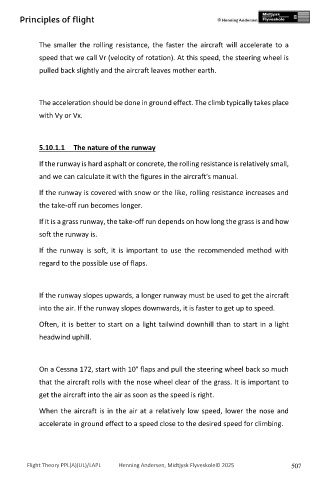Page 507 - PPL-engelsk 2025
P. 507
Principles of flight
The smaller the rolling resistance, the faster the aircraft will accelerate to a
speed that we call Vr (velocity of rotation). At this speed, the steering wheel is
pulled back slightly and the aircraft leaves mother earth.
The acceleration should be done in ground effect. The climb typically takes place
with Vy or Vx.
5.10.1.1 The nature of the runway
If the runway is hard asphalt or concrete, the rolling resistance is relatively small,
and we can calculate it with the figures in the aircraft's manual.
If the runway is covered with snow or the like, rolling resistance increases and
the take-off run becomes longer.
If it is a grass runway, the take-off run depends on how long the grass is and how
soft the runway is.
If the runway is soft, it is important to use the recommended method with
regard to the possible use of flaps.
If the runway slopes upwards, a longer runway must be used to get the aircraft
into the air. If the runway slopes downwards, it is faster to get up to speed.
Often, it is better to start on a light tailwind downhill than to start in a light
headwind uphill.
On a Cessna 172, start with 10° flaps and pull the steering wheel back so much
that the aircraft rolls with the nose wheel clear of the grass. It is important to
get the aircraft into the air as soon as the speed is right.
When the aircraft is in the air at a relatively low speed, lower the nose and
accelerate in ground effect to a speed close to the desired speed for climbing.
Flight Theory PPL(A)(UL)/LAPL Henning Andersen, Midtjysk Flyveskole© 2025 507

